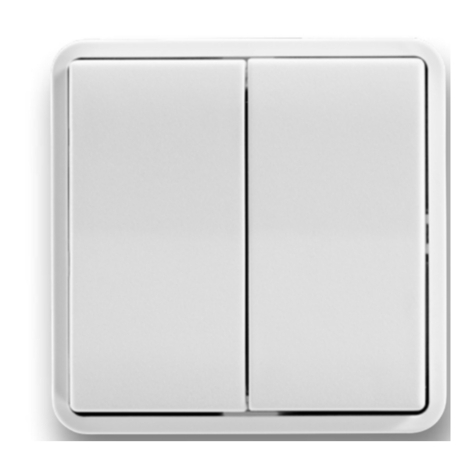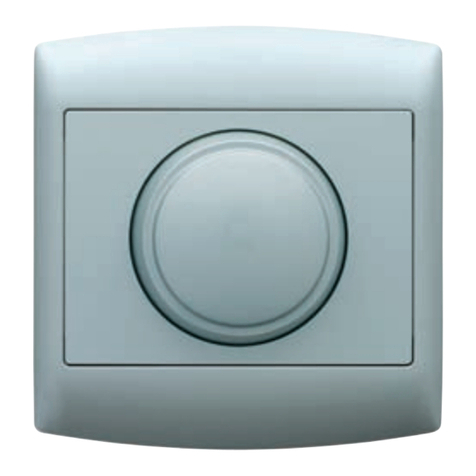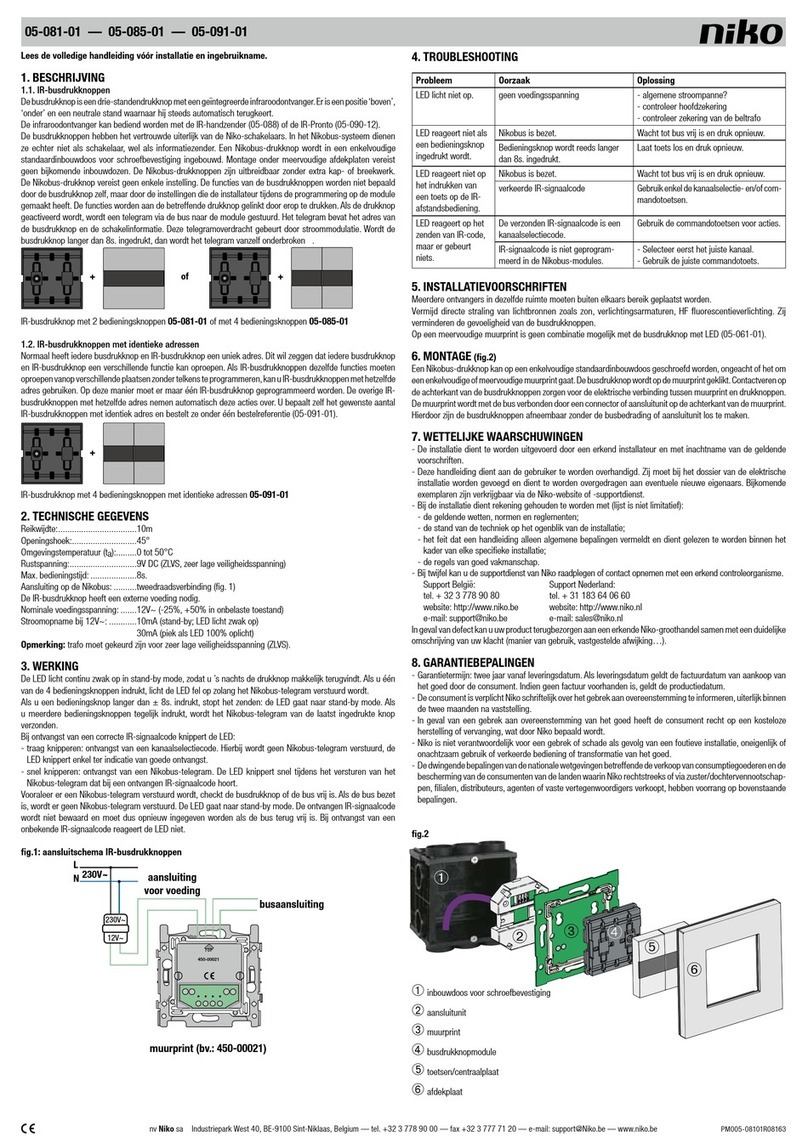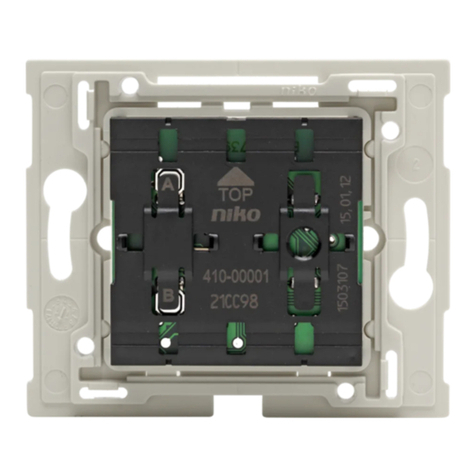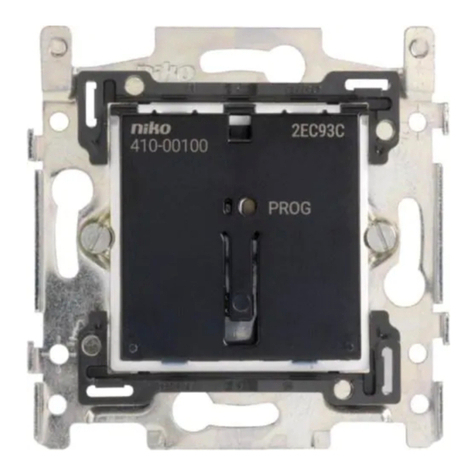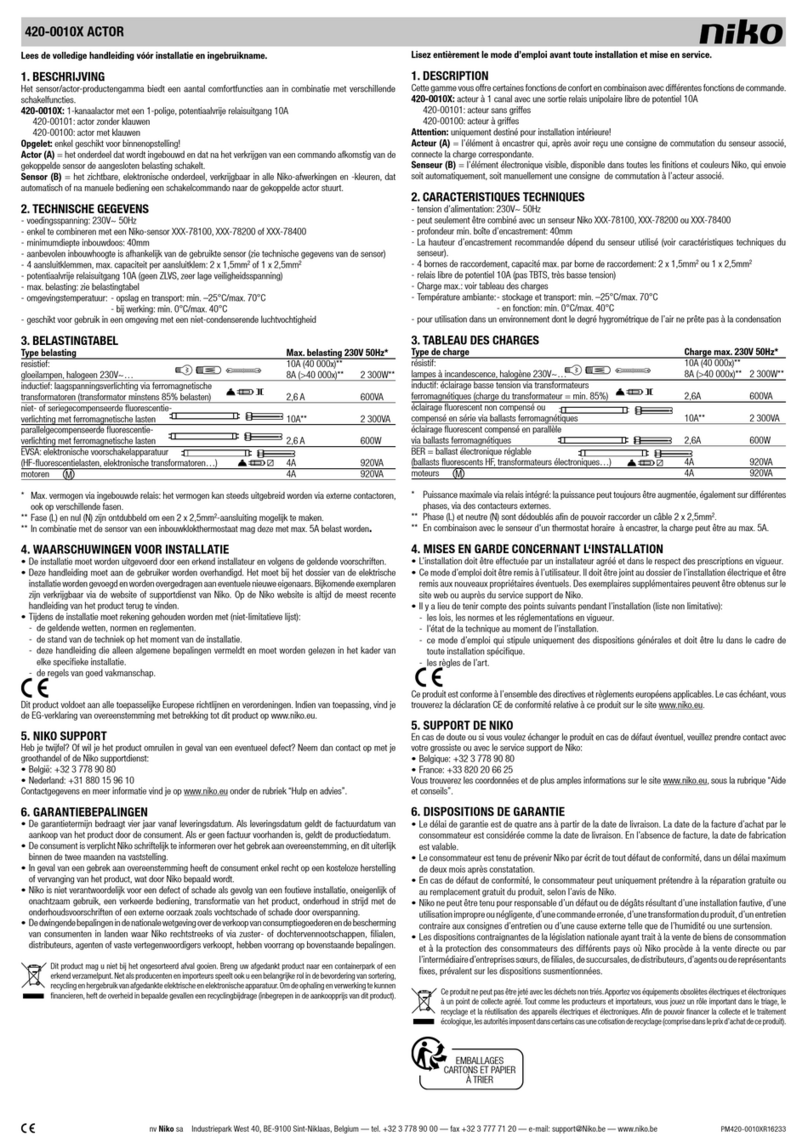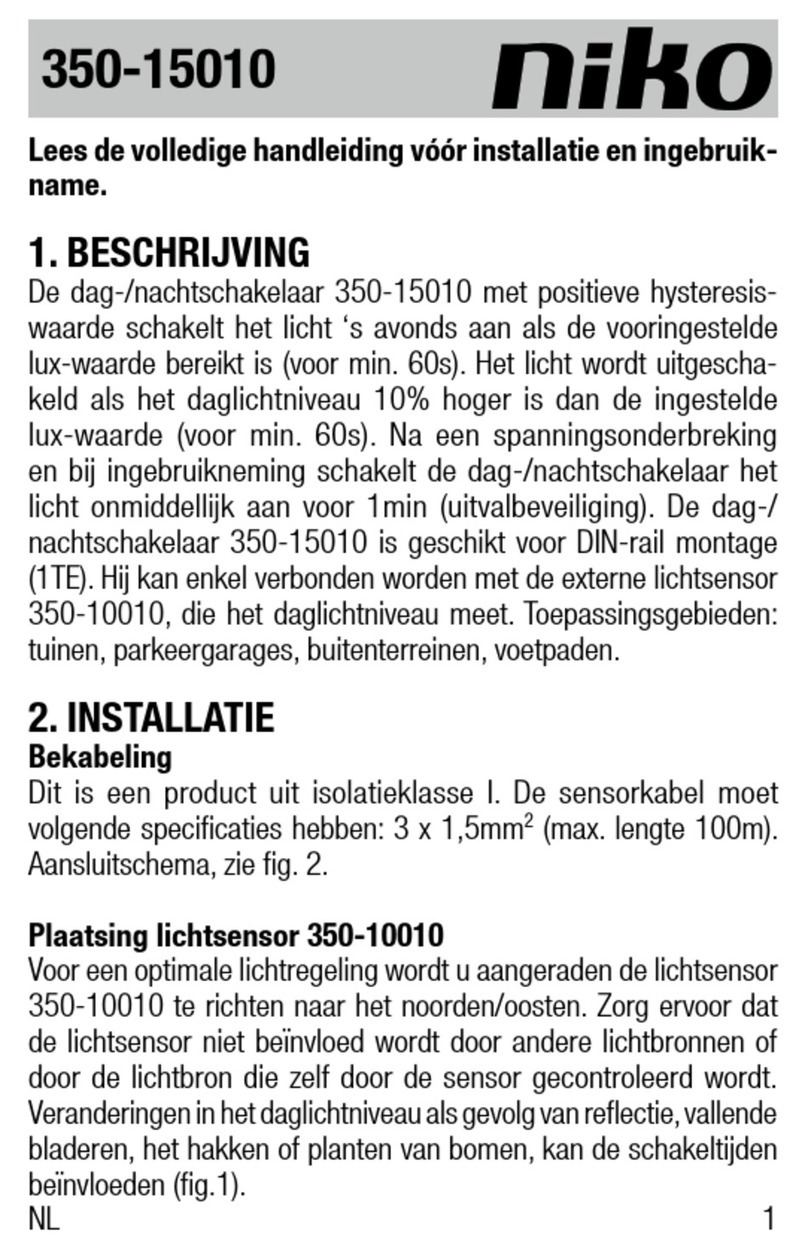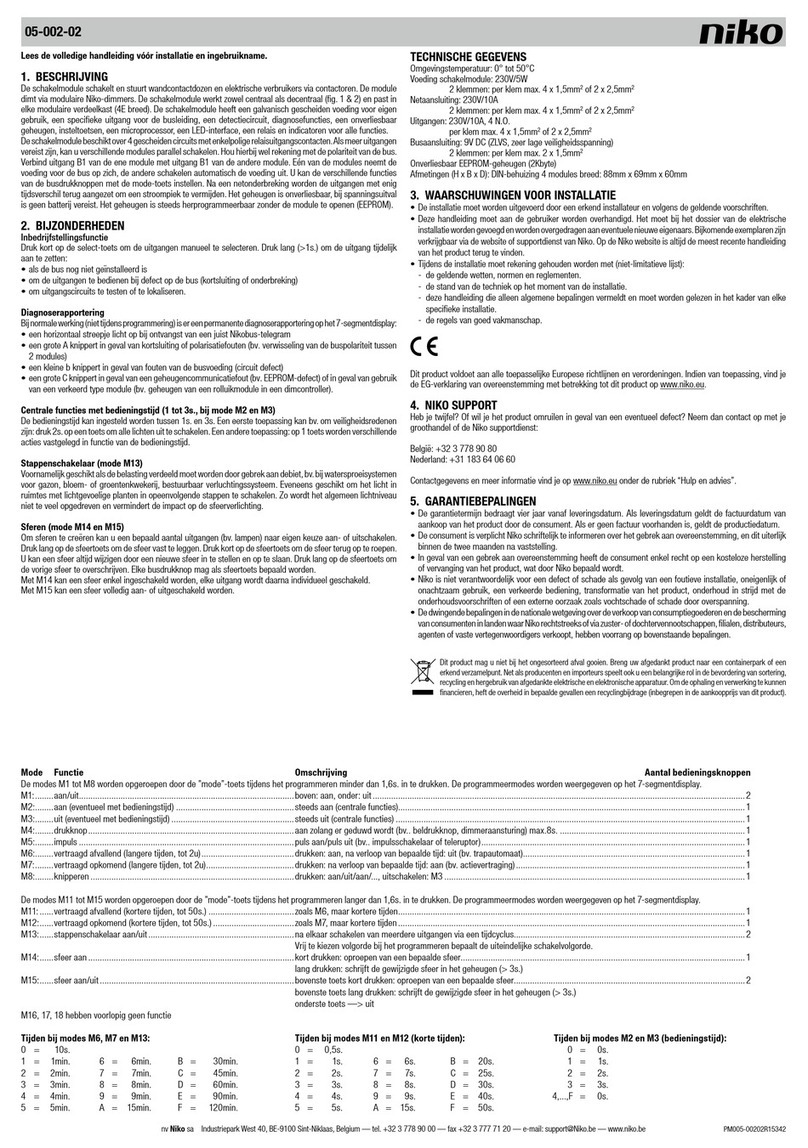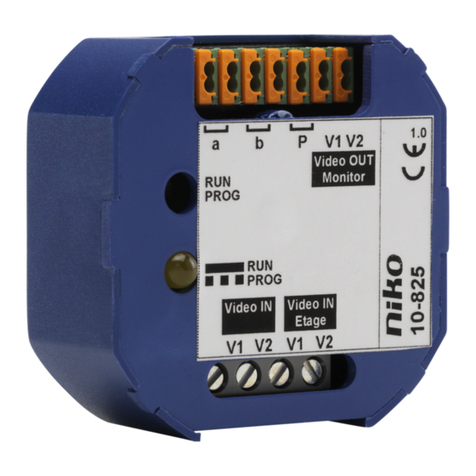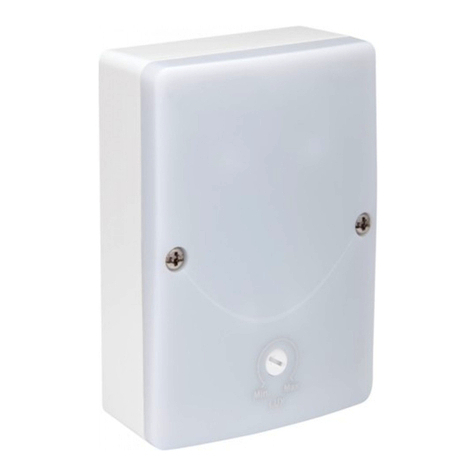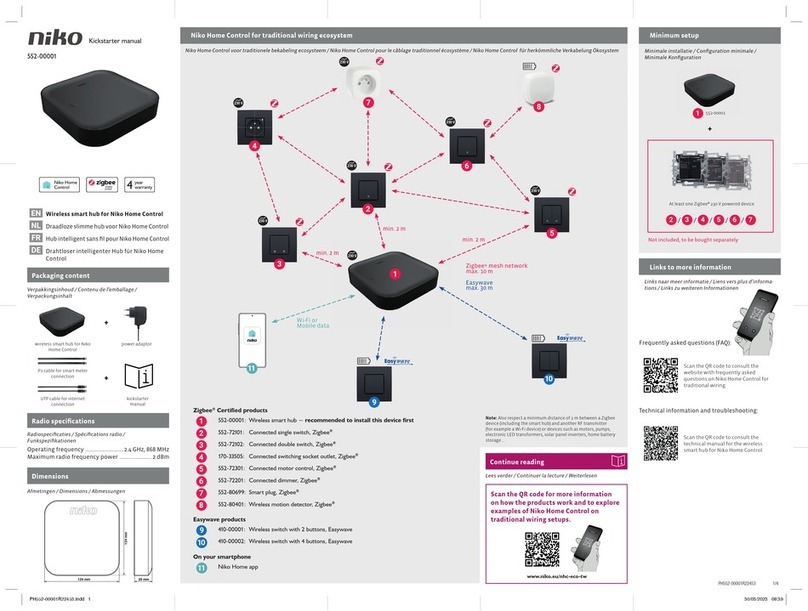
nv Niko sa Industriepark West 40, BE-9100 Sint-Niklaas, Belgium — tel. +32 3 778 90 00 — fax +32 3 777 71 20 — e-mail: support@Niko.be — www.niko.be PM005-00002R10111
05-000-02
Lesen Sie vor der Montage und Inbetriebnahme die vollständige Gebrauchsanleitung.
1. BESCHREIBUNG
Das REG-Schaltmodul schaltet elektrischeVerbraucher über die eingebauten Relais und dimmt mit den bekannten
Niko REG-Dimmern die unterschiedlichsten Leuchtmittel.Das REG-Schaltmodul arbeitet sowohl zentral, wie auch
dezentral (Zeichnung 1 & 2) und passt in jedemVerteilerkasten (14TE breit).Für die interne Stromversorgung besitzt
das Schaltmodul ein eingebautes,galvanisch getrenntes Netzteil, einen Busanschluss,eine Netzteilüberwachung,
einen spannungsaufallsicheren Speicher (steckbares EEPROM), Programmiertasten, einen Mikroprozessor,
einen Status-LED-Ausgang, 2 separate 230V-Eingänge, Relais und Anzeige-LED’s für alle Funktionen. Das
Schaltmodul verfügt über Diagnosemeldungen und über vorverdrahtete getrennte Stromkreise mit jeweils 6 + 3
einpoligen und 3 separaten Ausgangskontakten (12Ausgänge). Der EEPROM-Speicher ist wiederbeschreibbar und
spannungsausfallsicher, d.h. es wird keine Pufferbatterie benötigt. Das Speichermodul ist von außen zugänglich
und kann ohne öffnen des Schaltmoduls gewechselt werden.
Achtung: Der Wechselkontakt (Ausgang 6) ist nicht für die Ansteuerung von parallelkompensierten
Leuchtstofflampen geeignet.
2. FUNKTIONSWEISE UND ANWENDUNG
Werden meh als 12Ausgänge benötigt, so können mehrere Module parallelgeschaltet werden.Jeweils ein Modul
übernimmt dann die Spannungsversorgung für den Bus - die anderen Module schalten in diesem Fall ihre
Busversorgung automatisch ab. Die Funktionszuordnung der Relaisausgangskontakte bzw. der Busdrucktaster
kann gem. der Tabelle 'Modi' eingestellt werden. Auf den Ausgangsklemmen sind sowohl der Nulleiter als auch
die geschaltete Phase anschließbar. Nach einer Netzunterbrechung werden die Ausgänge die aktiv waren mit
einer unterschiedlichen kleinen Zeitverzögerung wieder zugeschaltet um Stromspitzen zu vermeiden. Bei jedem
Schaltmodul besteht die Möglichkeit den Status der letzten drei Ausgänge (10,11 und 12) über eine Status - LED
auf den Bustastern anzuzeigen. Die Versorgung dieser LED’s erfolgt über einen externen Klingeltrafo. Für diese
Statusmeldung werden 2 separate Adern des Buskabels benötigt, d.h. die Meldung erfolgt nicht über den Bus
selbst. Das Modul enthält außerdem 2 binäre 230V-Eingänge für Schalt- und 'Durchlass'-Funktionen.
Bei einem Dreiphasen-Anschluss darf pro Stromkreis eine einzelne Phase verwendet, aber in einer Gruppe
jedoch nur dieselbe Phase benutzt werden.
Die einzelnen Stromkreise bzw. Kontakte L4, L5 und L6 dürfen keine Sicherheitskleinspannungs-Stromkreise
(SELV) beschalten.
2.1. Inbetriebnahmefunktion
Drücken Sie die 'select'-Taste kurz, um einen der Ausgänge die manuell bedient werden sollen vorzuwählen.
Drücken Sie lang (>1s.), um dann den vorgewählten Ausgang zeitweise einzuschalten:
•wennderBusnochnichtinstalliertist
•fürdieBedienungderAusgängebeidefektemBus(KurzschlussoderUnterbrechung)
•zumTestenundLokalisierenderAusgangsstromkreise
2.2. Diagnosemeldungen
Im normalen Betrieb (nicht während der Programmierung) dienen die Modus-LED’s zur Diagnosemeldung:
M1 leuchtet beim Empfang eines korrekten Nikobus-Telegramms (blinkt bei Telegrammstörung)
M2 blinkt bei Kurzschluss oder Buspolaritätsfehler (z.B. Wechsel der Buspolarität zwischen 2 Modulen)
M3 blinkt bei Fehler in der Busversorgung (Defekt im Busversorgungstromkreis)
M4 blinkt bei Speicherkommunikationsfehler (z.B. EEPROM-Defekt) oder bei Verwendung eines falschen
Modultyps (z.B. Einstecken eines Rolladenmodulspeichers in ein Schaltmodul).
2.3. Externe 230V~-Eingänge mit 'logischen' Funktionen
Die 230V~-Eingänge A und B können als Schalter- oder als 'Enable'-Eingang (Durchlassfunktion) verwendet
werden.
2.3.1. Verwendung als Schaltereingang
- die Ausgänge reagieren auf Spannungsänderungen am Eingang, abhängig vom Modus
- die Aktion wird immer ausgeführt, unabhängig vom Bus
- das Signal dieser Eingänge hat Vorrang vor einem Nikobus-Telegramm
- nach einem Stromausfall werden die Funktionen entsprechend dem momentanen Status der Eingänge
ausgeführt.
Diese Eingänge können auch mit der logischen Funktion 'AND' programmiert werden. So kann man z.B. die
Außenbeleuchtung einschalten wenn der Zeitschalter und der Dämmerungsschalter auf 'ON' stehen.
2.3.2. Verwendung als 'Enable’-Eingang
Während der Programmierung kann man über einen separaten 230V~-Eingang eine zusätzliche Bedingung
mitgeben. Die Aktion kann nur dann ausgeführt werden bzw. nicht, wenn der Status des Eingangs 'ON' ist.
So kann man z.B. eine Lampe nur mit einem Bustaster eingeschaltet werden, wenn ein Dämmerungsschalter
'mitteilt', das es dunkel ist.
2.4. Zentrale Funktionen mit Bedienungszeit (1 bis 3s., für Modi M2 und M3)
Die Bedienungszeit einesTasters kann variabel zwischen 1 und 3s. eingestellt werden.Eine typische, sicherheits-
relevante Anwendung ist: Sie drücken erst 2s. auf einen 'Zentraltaster', bevor überall das Licht ausgeschaltet
wird. Eine andere Anwendungsmöglichkeit ist: auf einem Taster werden verschiedene Aktionen - abhängig von
der Bedienungszeit – hinterlegt.
2.5. Schieberegister (Modus M13)
Ein Schieberegister ist vor allem geeignet zur Durchflussmengenverteilung bei z.B.Wasserberieselunganlagen für
Rasen,Blumen- oder Gemüsegärtnereien, oder zur Lüftungssteuerung.Eine andere Anwendungsmöglichkeit ist die
schrittweise, zeitgesteuerte Beleuchtungssteuerung für Lagerhallen oder für die Pflanzenzucht mit Kunstlicht.
2.6. Lichtszenen (Modi M14 und M15)
Sie können eine bestimmte Anzahl Ausgänge (z.B. Lampen) nach Belieben auf ‚EIN’ oder 'AUS' einstellen.
Durch langes Drücken auf den 'Szenetaster' wird die Lichtszene abgespeichert. Durch kurzes Drücken auf den
'Szenetaster', wird die Lichtszene wieder aufgerufen. Sie können diese 'Lichtszene' auch immer ändern durch
langes Drücken auf den 'Szenetaster'. So wird die neue Lichtszene abspeichert und die alte überschrieben.
Jeder Bustaster, wie auch die externen 230V-Eingänge können als 'Szenetaster' verwendet werden. Mit M14
kann eine Lichtszene nur eingeschaltet werden. Jeder Ausgang wird danach individuell geschaltet. Mit M15
kann eine Lichtszene komplett ein- oder ausgeschaltet werden.
3. TECHNISCHE DATEN
Umgebungstemperatur: 0° bis +50°C
Netzteil REG-Schaltmodul: 230V/5W
2 Klemmen: pro Klemme max. 4 x 1,5mm2oder 2 x 2,5mm2
Netzanschluss: 230V/10A
5 x 2 Klemmen: pro Klemme max. 4 x 1,5mm2oder 2 x 2,5mm2
Ausgänge: 230V/10A, 1 x 6 Schließer + 1 x 3 Schließer + 2 x Schließer+ 1 x Wechsler = 12 Ausgänge
2 x 8 Klemmen: pro Klemme max. 4 x 1,5mm2oder 2 x 2,5mm2
Busanschluss: 9V DC Schutzkleinspannung (SELV)
2 Klemmen: pro Klemme max. 2 x 1,5mm2
Status LED Ausgang:Zur Statusrückmeldung der Ausgänge 10,11 und 12.Die Versorgung erfolgt durch separaten
Klingeltrafo (8-12 V AC) 4 Klemmen (pro Klemme max. 2 x 1,5mm2).
Externe 2 x 230V-Eingänge:
3 Klemmen: pro Klemme max. 2 x 1,5mm2oder 1 x 2,5mm2, 230V, 5mA, 2 Eingänge mit gemeinschaftlichem N
Spannungsausfallsicherer Speicher: steckbares EEPROM (2Kb)
Abmessungen: REG-Gehäuse, 14TE breit, H88mm x B251mm x T60mm)
4. GESETZLICHE BESTIMMUNGEN
- Die Installation darf ausschließlich von einem Fachmann des Elektrohandwerks unter Berücksichtigung der
geltenden Vorschriften vorgenommen werden.
- Übergeben Sie dem Benutzer diese Gebrauchsanleitung. Sie ist den Unterlagen der elektrischen Anlage
beizufügen und muss auch eventuellen neuen Besitzern übergeben werden. Zusätzliche Exemplare erhalten
Sie über unsere Website oder unseren Servicedienst.
- Bei der Installation müssen Sie u.a. Folgendes berücksichtigen:
- die geltenden Gesetze, Normen und Vorschriften;
- den Stand der Technik zum Zeitpunkt der Installation;
- diese Gebrauchsanleitung die im Zusammenhang mit jeder spezifischen Anlage gesehen werden muss;
- die Regeln fachmännischen Könnens.
- Sollten Sie Fragen haben, können Sie sich an die Niko-Hotline oder an eine anerkannte Kontrollstelle wenden:
Hotline Belgien: +32 3 778 90 80
Hotline Moeller Deutschland:
Berlin: +49 30 701902-46 Hamburg: +49 40 75019-281
Düsseldorf: +49 2131 317-37 Frankfurt a.M.: +49 69 50089-263
Stuttgart: +49 711 68789-51 München: +49 89 460 95-218
Mail: gebaeudeautomation@moeller.net
Österreich:
Moeller Gebäudeautomation UG Schrems 0043-2853-702-0
Im Falle eines Defektes an Ihrem Niko-Produkt, können Sie dieses mit einer genauen Fehlerbeschreibung
(Anwendungsproblem, festgestellter Fehler, usw.) an Ihren Moeller- oder Niko-EGH zurückbringen.
5. GARANTIEBESTIMMUNGEN
- Garantiezeitraum: Zwei Jahre ab Lieferdatum.Als Lieferdatum gilt das Rechnungsdatum zu dem der Endkunde
das Produkt gekauft hat. Falls keine Rechnung mehr vorhanden ist, gilt das Produktionsdatum.
- Der Endkunde ist verpflichtet, Niko über den festgestellten Mangel innerhalb von zwei Monaten zu informie-
ren.
- Im Falle eines Mangels an dem Produkt hat der Endkunde das Recht auf eine kostenlose Reparatur oder Ersatz.
Dies wird von Niko entschieden.
- Niko ist nicht für einen Mangel oder Schaden verantwortlich, der durch unsachgemäße Installation, nicht
bestimmungsgemäßen oder unvorsichtigen Gebrauch oder falsche Bedienung oder Anpassen/Ändern des
Produktes entsteht.
- Die zwingenden Vorschriften der nationalen Gesetzgebung bezüglich des Verkaufs von Konsumgütern und
der Schutz des Kunden in den Ländern in denen Niko direkt oder über seine Tochtergesellschaften, Filialen,
Distributoren, Handelsvertretungen oder Vertretern verkauft, haben Vorrang vor den obigen Bestimmungen.
Modi Funktion Beschreibung benötigte Tastpunkte
Drücken Sie die 'Modus'-Taste während der Programmierung <1,6s., um die Modi M1 bis M8 aufzurufen. Die Modus-LED’s leuchten dann mit Dauerlicht.
M1:........an/aus.............................................................................................oben: an, unten: aus ...................................................................................................................................................................2
M2:........an (eventuell mit Bedienungszeit) .....................................................Zentral-EIN.................................................................................................................................................................................1
M3:........aus (eventuell mit Bedienungszeit)....................................................Zentral-AUS................................................................................................................................................................................1
M4:........Taster..............................................................................................an, solange er gedrückt wird (z.B. Klingeltaster, Dimmeransteuerung) max.8s. ............................................................................1
M5:........Impuls .............................................................................................Impuls an/Impuls aus (z.B. Impulsschalter (ELTAKO))................................................................................................................... 1
M6:........Ausschaltverzögerung (längere Zeiten, bis 2St.) ...............................drücken: an, nach eingestellter Zeit: aus (z.B. Treppenhausschalter)............................................................................................ 1
M7:........Einschaltverzögerung (längere Zeiten, bis 2St.).................................drücken: nach eingestellter Zeit: an (z.B. Verzögerungsschaltung)................................................................................................1
M8:........Blinklicht..........................................................................................drücken: an/aus/an/..., ausschalten: M3......................................................................................................................................1
Drücken Sie die 'Modus'-Taste während der Programmierung >1,6s., um die Modi M11 bis M15 zu aktivieren. Die Modus-LED‘s blinken dann.
M11: ......Ausschaltverzögerung (kürzere Zeiten, bis 50s.)...............................wie M6, aber kürzere Zeit ...........................................................................................................................................................1
M12:......Einschaltverzögerung (kürzere Zeiten, bis 50s.)................................wie M7, aber kürzere Zeit............................................................................................................................................................1
M13:......Schieberegister ein/aus....................................................................Die gewünschte Reihenfolge ist beim Programmieren frei zu wählen und bestimmt den Ablauf der Schaltungen. ..........................2
nacheinander schalten mehrerer Ausgänge nach einem Zeitzyklus
M14:......Lichtszene ein..................................................................................kurz drücken: Aufrufen einer bestimmten Lichtszene...................................................................................................................1
lang drücken: Schreibt die geänderte Situation in den Speicher (> 3s.)
M15:......Lichtszene ein/aus...........................................................................oberen Taster kurz drücken: Aufrufen einer bestimmten Lichtszene .............................................................................................2
oberen Taster lang drücken: Schreibt die geänderte Situation in dem Speicher (> 3s.)
unteren Taster —> Lichtszene aus
M16, 17, 18 haben vorläufig keine Funktion
Bei Modi M6, M7 und M13: Bei Modi M11 und M12 (kürzere Zeit): Bei Modi M2 und M3 (Bedienungszeit):
0 = 10s. 0 = 0,5s. 0 = 0s.
1 = 1min. 6 = 6min. B = 30min. 1 = 1s. 6 = 6s. B = 20s. 1 = 1s.
2 = 2min. 7 = 7min. C = 45min. 2 = 2s. 7 = 7s. C = 25s. 2 = 2s.
3 = 3min. 8 = 8min. D = 60min. 3 = 3s. 8 = 8s. D = 30s. 3 = 3s.
4 = 4min. 9 = 9min. E = 90min. 4 = 4s. 9 = 9s. E = 40s. 4,...,F = 0s.
5 = 5min. A = 15min. F = 120min. 5 = 5s. A = 15s. F = 50s.

